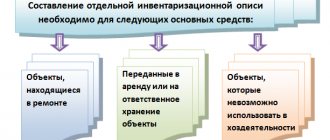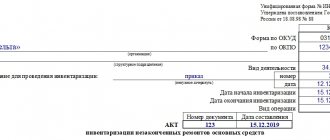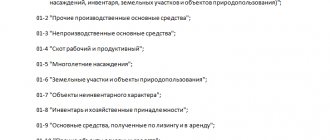The company systematically conducts an inventory of its own assets.
The goal is to check the correspondence between documentary information and the actual availability of property assets owned by the company. Monitoring of fixed assets (fixed assets) is of particular importance, since this property, as a rule, is characterized by significant value and retains its properties for a long time.
The results of the inventory may be different:
- full compliance of the real state of affairs with accounting data;
- identifying discrepancies in the form of surpluses or shortages.
Information about established surpluses/shortages for certain fixed assets is subject to mandatory reflection in the accounting system.
First of all, it is necessary to consider how surplus operating systems discovered during inventory are accounted for and accounted for.
Tasks of inventory of fixed assets
The frequency and sequence of inventory of fixed assets at the enterprise is enshrined in its accounting policy. It is carried out by an inventory commission specially appointed by the head of the enterprise. During this process the following goals should be achieved:
- monitoring the correctness of the preparation of primary documentation on the movement of fixed assets;
- establishing the presence of the organization’s property at the places of operation and storage, as well as its condition;
- detection of unused, missing or unaccounted for objects;
- control of the correct determination of the value of property in accounting and their reflection in the balance sheet of the organization.
What to do if the inventory reveals unaccounted assets?
When the inventory commission has completely completed the comparison (comparison) of factual information with accounting information, the head of the organization approves the results of the inspection by issuing an appropriate order.
A natural consequence of the execution of this administrative act will be the introduction of the necessary changes into the accounting (accounting) registers, determined by the results of the inventory. Thus, identified shortages are correctly written off, and surpluses found are correctly accounted for and are registered. An important clarification is that the inventory should be completely completed by the time the head of the company must sign the prepared reports. The necessary adjustments to the accounting registers are carried out by specialists on the date of the inventory procedure. Thus, the manager’s order ordering the capitalization of found surpluses is the legal basis for the proper correction of detected errors in accounting. An administrative act can be drawn up according to a template adopted in a particular organization.
How to capitalize identified objects?
Unaccounted for fixed assets discovered during a scheduled inspection are accounted for, as required by current standards, at market value.
It should also be clarified that the surplus found must be received exclusively on the date of the inventory.
Accounting rules provide for several options for crediting surplus fixed assets to income.
If you have any questions, you can consult for free via chat with a lawyer at the bottom of the screen or call by phone (consultation is free), we work around the clock.
The choice of a specific approach is determined by the specifics of the situation in which a specialist needs to capitalize a specific object discovered during the inventory process.
How to register a find during re-registration?
During the recalculation of property, surpluses may be discovered that arise for the following reasons:
- fixed assets were previously written off, but are still in use;
- the fixed asset is operated without documents confirming the enterprise's ownership of it and is not listed in the accounting registers.
Such “finds” should be capitalized. This procedure can be represented as follows:
| Stages of capitalization of surplus | Contents of the procedure |
| Determining the value of discovered property | An organization can independently determine the fair value of a discovered object that is not registered. Sources of information can be information about similar funds on the balance sheet of the enterprise, press materials, etc. To establish the value, you can use the services of a professional independent assessment. When determining the price of an object, it is necessary to take into account its condition, degree of wear and tear |
| Documenting | The director of the organization issues an order to capitalize surplus property discovered during the inventory. Based on the order, it is necessary to draw up an acceptance and transfer act, form OS-1, in which, as information about the receipt of the object, it should be indicated that it was discovered during the inventory. Then fill out the fixed asset inventory card. |
Business Solutions
- the shops
clothes, shoes, products, toys, cosmetics, appliances Read more
- warehouses
material, in-production, sales and transport organizations Read more
- marking
tobacco, shoes, consumer goods, medicines Read more
- production
meat, procurement, machining, assembly and installation Read more
- rfid
radio frequency identification of inventory items More details
- egais
automation of accounting operations with alcoholic beverages Read more
The program supports the simultaneous existence of multiple records on one TSD. In this way, you can conduct a check in several rooms/departments of the organization and then get several results at once in 1C.
Reflection of surpluses for accounting purposes
In accounting, discovered surpluses of fixed assets are classified as other income of the enterprise. Based on information about the discovered fixed assets in the inventory records, it is necessary to draw up an accounting statement that reflects the following entries:
- Dt 08 Kt 91/1 - for the cost of surpluses discovered during the inventory. The identified property can be used by the economic entity in the future in its activities;
- Dt 01 Kt 08 – a fixed asset item discovered during the inventory was put into operation.
Example. During an inventory of the enterprise's property carried out on October 15, 2021, a new monitor that was not previously taken into account was discovered. There are no primary documents for it. It has been established that the market value of a similar model is 60,000 rubles. The commission determined the useful life of the monitor to be 50 months.
The following entries should be made in accounting:
Dt 08 Kt 91/1 = 60000 – for the cost of property discovered during the inventory;
Dt 01 Kt 08 = 60000 – the detected object is put into operation;
Dt 20, 44 Kt 02 = 60000/50 = 1200 - monthly from November 2021 for the amount of accrued depreciation.
Financially responsible person
Verification of the actual availability of property is carried out with the obligatory participation of financially responsible persons (clause 2.8 of the Methodological Instructions). At the same time, such employees give receipts stating that by the beginning of the inventory, all expenditure and receipt documents for property were submitted to the accounting department or transferred to the commission and all valuables received under their responsibility were capitalized, and those disposed of were written off as expenses (clause 2.4 of the Methodological Instructions).
Reflection of surpluses for tax accounting purposes
In tax accounting, the opportunity to reflect property as part of fixed assets appears only if the following conditions are simultaneously met:
- the object must be the property of the enterprise;
- the fixed asset will be used to generate income;
- the service life of the property must be more than 1 year;
- the initial cost of the fixed asset should not be less than 40,000 rubles.
If an object discovered during an audit of fixed assets does not meet one of the listed conditions, then it should be taken into account as part of the inventory.
Particular attention must be paid to property valuation. The initial cost of a fixed asset is the amount of its valuation. In this case, the assessment must be documented or carried out by an independent specialist. If the valuation of the discovered property is carried out by the enterprise itself, then official sources of information on the prices of similar goods can be used as a source of data on the value.
Surpluses are recognized as non-operating income; accordingly, the value of such property is subject to taxation.
In tax accounting, compared to accounting, a difference is formed - a permanent tax liability for income tax, which is reflected: Dt 99 Kt 68.
Unaccounted for property
It happens that some of the company’s property is not capitalized on time. This can be caused by various reasons: the accountant “forgot” to register the valuables, the supplier’s documents were “lost” irretrievably, the things were purchased by the director with his own money, etc. But sooner or later such property will have to be reflected on the balance sheet. What's the best way to do this? There are several ways.
Y. Nikerova, expert of the “Modern Tax Encyclopedia” berator Whichever one suits you, use it. In this case, the procedure for paperwork, accounting and taxation will be different for each case. So, the property can be reflected as:
- additional contribution of the founder-citizen;
- “purchase” from an employee;
- “rent” from an employee;
- personal property of the employee for the use of which compensation is due;
- “received free of charge” from a citizen;
- “identified” during inventory.
Let’s make a reservation right away: no matter which of the listed options you choose, there can be no question of any offset of input VAT. There's probably no need to explain why. After all, the main condition for obtaining a VAT deduction is the presence of an invoice (Clause 1, Article 172 of the Tax Code of the Russian Federation). But you won’t have exactly these documents. Since in the first five cases the value will be given to you by a person. And people, as you know, are not VAT payers, so they do not issue invoices (Article 143 of the Tax Code of the Russian Federation). Due to the absence of an invoice, there will be no input tax on property “identified” during the inventory. After all, the supplier from whom the company could once purchase this property and receive purchase documents (including an invoice) can no longer be found. Now let's look at each of the options in more detail.










